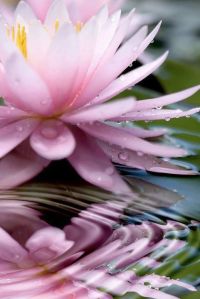Happy Saturday! Hope you enjoy the weekend :) Now that summer is here, I thought I would write about something central to this time of year. Namely flowers. Not just any flowers, but those that have a meaning in Hinduism and Indian culture.
When we visit friends it is often customary to bring a bouquet of flowers to the host, likewise it is customary in Hinduism to bring flowers, incense and coconut when we visit a temple, the home of God. As a welcome for highly respected guests, nobles, politicians or people, a garland of tagetes flowers is still given around the neck as a kind of tribute. When the groom arrives for the wedding ceremony, the first ritual is that the bride welcomes him with a large garland of red roses around his neck and receives the same from her beloved.
Flowers create a pleasant atmosphere and provide positive energy. In old Indian tales, we hear about kings who spent time in flower gardens when they had a lot to think about and needed harmony and good energy (the concept of “stress” did not exist then). In India, you can find especially many marigolds, roses, jasmine, lotus, bougainvillea, lilies, sunflowers, clematis, gladioli, etc. marigolds and roses have a special position in all kinds of rituals, prayer, weddings and death.

The lotus flower holds the highest place in both prayer and depictions of the divine, Hindus are captivated by the lotus flower because it is the foremost symbol of beauty, prosperity and fertility. It appears beautiful and pure above mud and dirty water. According to Hinduism, every human being is a spirit of the sacred lotus. It represents eternity, purity, divinity, and is widely used as a symbol of life, fertility and renewal. Lotus is used as a description of feminine beauty, especially the eyes. The word puja (prayer) can be translated as flower action.
One of the central postures in hatha yoga is the lotus position (padmasana) adopted by those striving to reach the highest level of consciousness, which is found in our highest chakra (energy point) at the top of the head. This energy point is symbolized as a white lotus with a thousand petals.
In the Bhagavad Gita, man is entreated to be like the lotus; that is, to act without attachment, dedicating his actions to God, untouched by sin like water on a lotus leaf, like a beautiful flower standing tall above mud and water. Goddess Lakshmi, the patroness of wealth and happiness, sits on a fully blossomed pink lotus as her divine seat and holds a lotus in her right hand.
